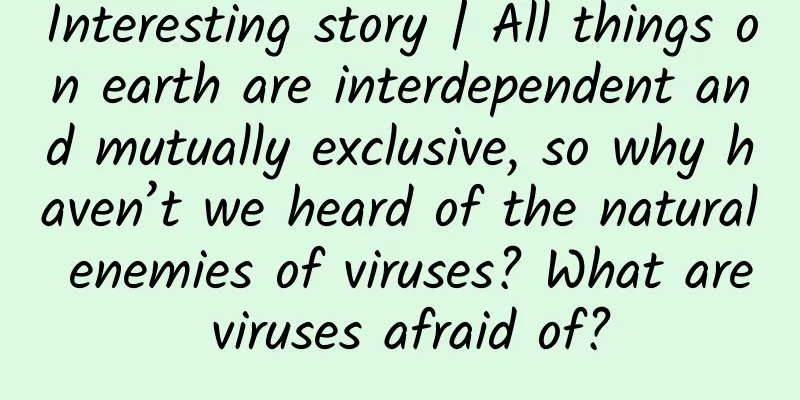Interesting story | All things on earth are interdependent and mutually exclusive, so why haven’t we heard of the natural enemies of viruses? What are viruses afraid of?

|
We all know that animals have their own world. Even the most powerful lions and tigers have something they fear, and that is humans. So, do we humans have natural enemies? Yes, we do, but we may not have noticed it ourselves. In history, viruses have killed the most people. Viruses are organisms with very primitive structures. They don’t even have a cellular structure, but they have become humanity’s number one enemy through mutation. So what are the natural enemies of viruses? To understand the natural enemy of the virus, we should understand the origin of the virus. However, viruses are the most mysterious life in the world, and scientists have been unable to trace their origins to this day. The birth of a virus We all know that all living things can be traced back to their origins. For example, humans and bananas, although seemingly unrelated, actually have 50% of their genes in common. This shows that animals and plants actually come from the same ancestor, but we parted ways very early. However, no matter how scientists reverse time, they cannot find out when the virus was born. What is their relationship with us? Some people even think that viruses cannot be called living things because they have no cell structure. All the known organisms with cell structures, whether eukaryotic cells or prokaryotic cells, come from the earliest ancestor "Luca". It is obvious that the virus is not Luca's offspring, it is more like a hybrid of organic molecules. The structure of a virus is very simple, it is a protein shell wrapped around genetic material, this genetic material may be DNA or RNA. Viruses cannot leave living things, otherwise they will become dead things. Therefore, scientists speculate that the origin of viruses is likely to be the earliest molecular life. Because they do not have cellular structure, they can only parasitize near seabed hot springs. Later, the most primitive cell structure appeared in life represented by Luca, which changed the whole world. Luca's cell structure is a dimensionality reduction attack on viruses, and it will be easier for it to seize favorable hot spring vents than viruses. So under such a blow, the viruses gradually "pervert"; since their position has been taken away by the cells, they attach themselves to and parasitize on the cells, and they will not die as long as the cells do not die. This is the molecular life hypothesis about viruses, and if it is true, then viruses are far older than any organism we have today. As scientists conduct research, they discover that viruses may not be as ancient as we imagined. Through DNA sequence testing, it was found that the virus has a very high similarity with the DNA of many organisms. Scientists have discovered that animals and plants separated in the Ediacaran period, about 800 million to 570 million years ago, so we and bananas only have half of our genes in common. If viruses had started on a different track from cellular life 3.8 billion years ago, then their genetic similarity with cellular organisms could not have been so high. This seems to indicate that viruses are not necessarily molecular life left over from ancient times, but rather were born from cellular life. The most terrifying discovery is that the genetic sequences of some viruses are very similar to a certain human DNA fragment, with only a few base pairs different, as if it were a piece cut from the human gene. This gave rise to a hypothesis that frightened the world: the virus might be a rebellion of the biological genes, and the rebellious genes left the DNA system of the entire organism and formed their own lineage. This hypothesis also explains why viruses become the natural enemies of humans, because traitors are always the most harmful. Virus's natural enemy Since some scientists believe that the origin of the virus comes from the genetic rebellion of the organism itself, the only thing that can subdue the virus is the organism itself, and the natural enemy of the virus is the immune system in the organism. Taking our human body as an example, the human immune system has three lines of defense. The first line of defense is our skin and various mucous membranes, such as nasal mucosa, oral mucosa, etc. The first line of defense can directly prevent some bacteria from entering the human body and kill these viruses through methods such as washing hands. As mentioned earlier, viruses that do not parasitize into living organisms are no different from dead objects and can be washed away even with clean water. The second line of defense is the phagocytes in the human body, which directly "swallow" the virus into the cells and absorb it as nutrients. But there are also a group of viruses that are cunning and can deceive macrophages and enter the human body. At this time, the third line of immune defense must be mobilized, various immune cells, which analyze the invading viruses and produce antibodies specifically to fight them. When the virus comes again next time, the third line of defense will directly use antibodies to eliminate the virus quickly, accurately and ruthlessly. Antibodies not only kill a certain type of virus, they also have a certain inhibitory effect on the entire family of viruses. For example, smallpox, the only virus eradicated by humans, has a member in its family called cowpox virus. The cowpox virus mainly targets cows and does not cause serious harm to humans. The cowpox virus can be easily transmitted to workers who often deal with cows. It is difficult for these people to be infected with the smallpox virus after being infected with the cowpox virus. This also gave inspiration to the scientists at the time, and they made the first vaccine by using the cowpox virus. However, not all viruses are afraid of biological antibodies. Some viruses are very aggressive. After infecting humans, they enter human cells at the fastest speed, disintegrate the cells, and use the cells' raw materials to replicate themselves. The speed is very fast, and there is no time for the immune system to detect it, so even if the immune cells want to produce antibodies, it is too late. For example, the Ebola virus has a mortality rate of about 90%, and humans have no chance to produce relevant antibodies. This type of virus generally occurs across species, such as viruses from animals being transmitted to humans. Why does this happen? We have to mention a consensus reached between viruses and organisms during their long-term coexistence - symbiosis. Viruses and symbiosis Perhaps humans don't know that there are at least 140,000 viruses hidden in their bodies, and they usually coexist peacefully with humans. If humans use medical conditions to eliminate them, humans will definitely die in the end. Some of these viruses have been with humans for a very long time. Biologists' research has found common types of viruses in the intestines of apes, indicating that some viruses existed before humans differentiated from apes. These viruses, to some extent, maintain human health because their existence will constantly stimulate immune cells to remain active, thereby driving other immune functions and improving human immunity. If humans eliminate these viruses, it is very likely that the existing body environment will be destroyed. The immune system will lose this "stimulation" and will begin to become lazy, thereby reducing human immunity. Of course, this process may also be disrupted by foreign viruses. If some viruses that are not inherent to the human body invade, it will cause chaos. It's like Sun Wukong is not a god in heaven. Even if you let him be the horse keeper, he can't be integrated into the entire heaven system, so he is destined to make trouble in heaven. The same goes for these foreign viruses. They do not belong to the human body's viral environment and cannot integrate into it, so they naturally cause trouble. The result of this trouble is that they disrupt the normal functioning of the human body and make humans sick. We all know that after Sun Wukong made havoc in the Heavenly Palace, Heaven had no choice but to ask Tathagata Buddha for help. Without Tathagata, Heaven would have been destroyed by Sun Wukong. You can imagine the Buddha as an antibody. If the body cannot produce antibodies against the virus, the human body will be broken down by the virus. So when you catch a cold, you think that the medicine kills the virus. In fact, this idea is wrong. Human beings have not yet developed a medicine that can directly kill the virus. It is always the antibodies in the human body that kill the virus. Whether it is the medicine we take or the vaccine we get, it is essentially stimulating the human immune system to produce antibodies faster. We love and hate viruses. We coexist with each other and are natural enemies of each other. This may be the way nature has set the program. Our ancestors saw through this phenomenon long ago and called it "the mutual promotion and mutual restraint of all things." (Statement: This article is from Cosmic Decoding. It is reproduced for learning and communication only, not for commercial purposes. All reproduced articles will indicate the source. If the original author of the article or photo has any objection, please contact us in the background and we will quickly process or delete it. Thank you for your support.) |
<<: Why don’t I recommend you to eat raw pickled or raw water chestnuts?
>>: Why does foaming hand sanitizer produce foam with just one press?
Recommend
Information flow methodology helps you reduce costs by 40%!
There are a lot of form leads, but few transactio...
How can you become a marketing expert without talent?
When you are engaged in marketing- related work, ...
Is the famous Northeastern dish, pine nut corn, authentic? The pine nut is the authentic flavor!
Pine nut corn is a traditional dish of the Han na...
Hoarseness is so common, why does it never get better?
Some time ago, actress Qin Lan's cute "e...
Pan Zhanle: Winning gold + breaking competition records = aerobic training! How to distinguish between aerobic and anaerobic training?
Review expert: Peng Guoqiu, deputy chief physicia...
Sir Tang said: Live Screen Recording Column + Live Streaming Required Column
Sir Tang said: Live Screen Recording Column + Liv...
iOS/iPad OS 14.8.1 released: Apple recommends upgrading all older iPhone models
Not long after the official release of iOS 15.1, ...
In the bitter winter, why is it Xiaomi that helps Xiaopeng Electric Vehicles survive?
New energy vehicles are an inevitable future, but...
How is the call quality of 400 number?
After applying for 400 telephone numbers , many c...
Get APP growth analysis report
1. Background and Purpose background Recently, I ...
Pensions in all 31 provinces have increased! How much has it increased specifically? Attached is a list of the latest price increases in various regions!
As of now, the 2020 pension increase has ended, a...
How to speed up NFC development?
In 2014, thanks to Apple's participation, NFC...
Back to school season | 5 common infectious diseases in children in spring, parents must be vigilant!
As the saying goes, "Early spring, early spr...
Can "eating dirt" cure enteritis? What kind of weird linkage is this?
Recently, a new research result published in Natu...









